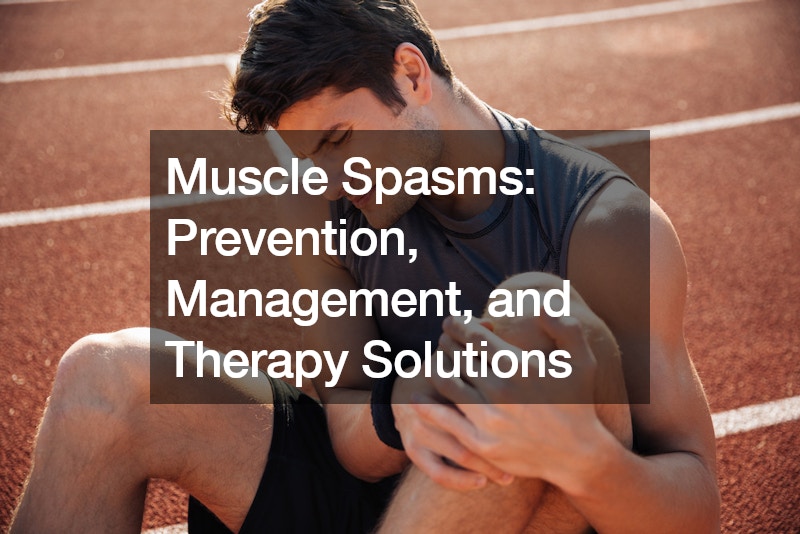Muscle spasms can be a sudden and painful experience, disrupting your daily routine and causing significant discomfort. These involuntary contractions of muscles can occur at any time and can vary from minor annoyances to major problems that hinder your ability to function. Understanding how to prevent, manage, and treat muscle spasms is essential for maintaining a pain-free and active lifestyle.
What Are Muscle Spasms?
A muscle spasm is an involuntary contraction of a muscle that can be difficult to relax. Sometimes, the muscle remains contracted for an extended period, while other times, it contracts and releases on its own.
Muscle spasms can affect any muscle in the body, but they most commonly occur in the hands, feet, calves, and lower back.
Common Causes of Muscle Spasms
Several factors can contribute to the occurrence of muscle spasms:
1. Dehydration: Staying hydrated is crucial for muscle function. When your body lacks adequate water, your muscles can become tight and prone to spasms.
2. Overexertion: Intense physical activity can lead to muscle spasms, especially if you lose a significant amount of water and electrolytes through sweat.
3. Mineral Imbalances: An imbalance in minerals such as sodium, magnesium, and potassium can affect muscle contractions and lead to spasms.
4. Nerve Compression: Tight muscles can compress nerves, causing excessive muscle stimulation and spasms.
5. Medical Conditions: Certain medical conditions, including neurological disorders like Parkinson’s disease, ALS, and spinal cord injuries, can increase the risk of muscle spasms.
6. Medications: Some medications, especially diuretics and statins, can cause muscle spasms as a side effect.
How to Prevent Muscle Spasms
Preventing muscle spasms involves taking proactive steps to maintain muscle health and avoid the triggers that cause them. Here are some tips:
Stay Hydrated: Drink plenty of water throughout the day to keep your muscles hydrated and functioning properly.
Balance Electrolytes: Ensure your diet includes foods rich in essential minerals such as sodium, magnesium, and potassium.
Avoid Overexertion: Gradually increase the intensity of your workouts to prevent overexertion and allow your muscles to adapt.
Stretch Regularly: Incorporate stretching exercises into your routine to keep your muscles flexible and reduce the risk of spasms.
Manage Stress: Practice stress-reducing techniques like yoga, meditation, or deep breathing to prevent tension and muscle tightness.
Managing Muscle Spasms
If you experience muscle spasms, there are several management strategies you can use to alleviate the pain and discomfort:
Apply Heat or Cold: Use a heating pad or ice pack on the affected area to relax the muscle and reduce spasms.
Massage: Gently massaging the spasming muscle can help increase blood flow and relieve tightness.
Stretch the Muscle: Slowly stretch the affected muscle to help it relax and reduce the spasm.
Stay Active: Light physical activity, such as walking or gentle exercises, can help prevent muscle stiffness and spasms.
Therapy Solutions for Muscle Spasms
Physical therapy can be a crucial part of managing chronic or acute muscle spasms. Physical therapists are trained to assess your muscle function and develop personalized treatment plans to address your specific needs. Here are some ways physical therapy can help:
Assessment: Physical therapists evaluate your range of motion, muscle tone, and mobility to identify any underlying issues contributing to muscle spasms.
Customized Exercises: They create tailored exercise programs that include stretching, strengthening, and mobility exercises to improve muscle function and prevent spasms.
Education: Physical therapists provide education on proper posture, ergonomics, and lifestyle changes to reduce the risk of muscle spasms.
Manual Therapy: Hands-on techniques, such as massage and manipulation, can help decrease muscle tone, increase blood flow, and relieve spasms.
Electrical Stimulation: Techniques like electrical stimulation (e-stim) can relax muscles, improve circulation, and reduce the frequency of spasms.
Conclusion
Muscle spasms can be disruptive and painful, but with the right prevention, management, and therapy strategies, you can reduce their impact on your life. Staying hydrated, maintaining a balanced diet, and incorporating regular stretching and physical activity into your routine are essential steps. If you experience frequent muscle spasms, consider consulting with physical therapists who can provide personalized care and help you achieve pain-free movement.
.



